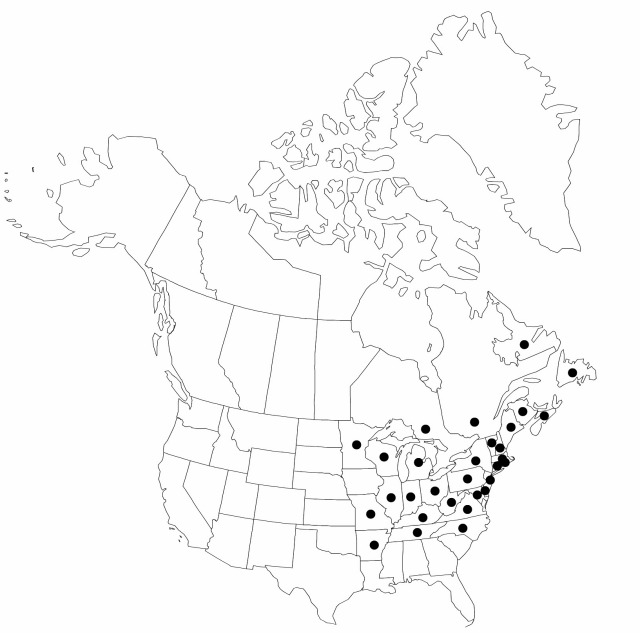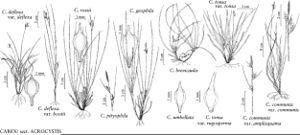familyCyperaceae
genusCarex
sectionCarex sect. Acrocystis
speciesCarex communis
varietyCarex communis var. communis
Carex communis var. communis
Common names: Carex commun
Pistillate scales 2.5–4.1 × 1.2–1.6 (–2) mm, apex usually acuminate, sometimes awned, equaling or shorter than perigynia. Perigynia 2.8–3.8 × 1.2–2.6 mm; beak 0.5–2.3 mm, apical teeth 0.1–0.3 mm. 2n = 28.
Phenology: Fruiting late Apr–late Jun.
Habitat: Poor to rich, well-drained soils of dry to moist woods and clearings, in partial shade of deciduous and mixed deciduous-coniferous forests, crevices and ledges of bluffs, slopes
Elevation: 50–1000 m
Distribution
Loading map...

N.B., Nfld. and Labr., N.S., Ont., Que., Ark., Conn., Del., Ill., Ind., Ky., Maine, Md., Mass., Mich., Minn., Mo., N.H., N.J., N.Y., N.C., Ohio, Pa., R.I., Tenn., Vt., Va., W.Va., Wis.
Discussion
Selected References
None.
Lower Taxa
None.
"shortened" is not a number.
... more about "Carex communis var. communis"
pale-brown +
globose;obovoid round +
1mm;1.4mm +
more prominent +
basifixed +
shorter +
acuminate +
equaling +
fibrous +
not fibrous +
ciliate-serrulate +
straight +
bent +
longer +
absent +
glabrous +
v--shaped +
leaflike +
1;many +
2;3 +
separated +
Carex commun +
shorter +
scabrous +
basal +
abundant +
single +
unisexual +
Poor to rich, well-drained soils of dry to moist woods and clearings, in partial shade of deciduous and mixed deciduous-coniferous forests, crevices and ledges of bluffs, slopes +
Present +
pistillate +
racemose +
pseudoumbel +
modified +
basal +
gynecandrous +
green +
1.8mm;5mm +
absent +
white +
fused +
broad +
strong +
more prominent +
distinct +
arranged +
falling +
absent +
with - 1-3-6 - -30 bristles and/or scales +
thin +
veinless +
pale green +
ascending +
exceeding +
2-3 - -4-carpellate +
fused +
pistillate +
subtending +
sheathless +
usually shorter +
Mem. Torrey Bot. Club +
1889 +
arranged +
ascending +
absent +
adventitious +
fibrous +
pistillate +
shorter +
1;0;1 +
fertile +
elliptic;obovate +
membranous +
cylindric +
arranged +
2;3 +
1-flowered +
distinct +
papillate +
undivided +
deciduous +
2-3 - -4-fid +
Carex communis var. communis +
Carex communis +
variety +
staminate +
free +
thin +
perennial +
short to long +
herbaceous +
